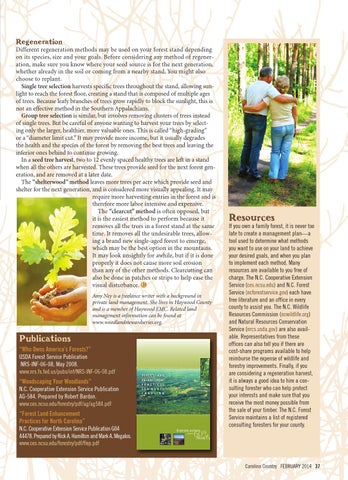s
Ney
ds ill ld-
of ype ty,
o-
g
e n -
ge
m-
Regeneration Different regeneration methods may be used on your forest stand depending on its species, size and your goals. Before considering any method of regeneration, make sure you know where your seed source is for the next generation, whether already in the soil or coming from a nearby stand. You might also choose to replant. Single tree selection harvests specific trees throughout the stand, allowing sunlight to reach the forest floor, creating a stand that is composed of multiple ages of trees. Because leafy branches of trees grow rapidly to block the sunlight, this is not an effective method in the Southern Appalachians. Group tree selection is similar, but involves removing clusters of trees instead of single trees. But be careful of anyone wanting to harvest your trees by selecting only the larger, healthier, more valuable ones. This is called “high-grading” or a “diameter limit cut.” It may provide more income, but it usually degrades the health and the species of the forest by removing the best trees and leaving the inferior ones behind to continue growing. In a seed tree harvest, two to 12 evenly spaced healthy trees are left in a stand when all the others are harvested. These trees provide seed for the next forest generation, and are removed at a later date. The “shelterwood” method leaves more trees per acre which provide seed and shelter for the next generation, and is considered more visually appealing. It may require more harvesting entries in the forest and is therefore more labor intensive and expensive. The “clearcut” method is often opposed, but it is the easiest method to perform because it removes all the trees in a forest stand at the same time. It removes all the undesirable trees, allowing a brand new single-aged forest to emerge, which may be the best option in the mountains. It may look unsightly for awhile, but if it is done properly it does not cause more soil erosion than any of the other methods. Clearcutting can also be done in patches or strips to help ease the visual disturbance.
Resources
If you own a family forest, it is never too late to create a management plan—a tool used to determine what methods you want to use on your land to achieve your desired goals, and when you plan to implement each method. Many resources are available to you free of charge. The N.C. Cooperative Extension Service (ces.ncsu.edu) and N.C. Forest Service (ncforestservice.gov) each have Amy Ney is a freelance writer with a background in free literature and an office in every private land management. She lives in Haywood County county to assist you. The N.C. Wildlife and is a member of Haywood EMC. Related land Resources Commission (ncwildlife.org) management information can be found at and Natural Resources Conservation www.woodlandstewardseries.org. Service (nrcs.usda.gov) are also available. Representatives from these Publications offices can also tell you if there are “Who Owns America’s Forests?” cost-share programs available to help USDA Forest Service Publication reimburse the expense of wildlife and NRS-INF-06-08, May 2008. FOREST LAND ENHANCEMENT PRACTICES FOR NORTH CAROLINA forestry improvements. Finally, if you www.nrs.fs.fed.us/pubs/inf/NRS-INF-06-08.pdf are considering a regeneration harvest, OR RE ES S TT LL A AN ND D FF O ENHANCEMENT ENHANCEMENT it is always a good idea to hire a con“Woodscaping Your Woodlands” PR RA AC C TT II C CE ES S P OR R N NO OR R TT H H sulting forester who can help protect FF O N.C. Cooperative Extension Service Publication CA AR RO O LL II N NA A C your interests and make sure that you AG-584. Prepared by Robert Bardon. receive the most money possible from www.ces.ncsu.edu/forestry/pdf/ag/ag584.pdf the sale of your timber. The N.C. Forest “Forest Land Enhancement FOREST LAND ENHANCEMENT PRACTICES FOR NORTH CAROLINA Service maintains a list of registered Practices for North Carolina” consulting foresters for your county. N.C. Cooperative Extension Service Publication G04 forests cover % of 60 44478. Prepared by Rick A. Hamilton and Mark A. Megalos. North Carolina
c
almost
www.ces.ncsu.edu/forestry/pdf/flep.pdf
1
Carolina Country february 2014 37
CC02-tv.indd 37
1/13/14 10:45 AM
